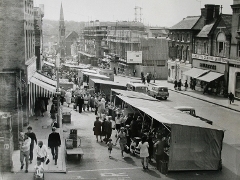Guildford Markets - what were they like in Elizabethan times?

As a result of coronavirus, are you taking your food a little less for granted? It would seem we are realising just how important the people who grow and supply our food are. Guildford is fortunate to have a twice-weekly general food market, in North Street, and the monthly Farmers' Market in the High Street. In our May blog post, Guildford Museum Friend and Town Guide Nick Bale looks back at the markets that existed in Guildford over four hundred years ago.
We are fortunate that a report has survived from 1592, written during the reign of Queen Elizabeth I, that describes how the weekly market was laid out in the High Street.
Information on daily life, such as markets, is often quite sparse in this period so this is wonderful to have. It tells us that most of the market stalls in Guildford were on the sides of the street between the Guildhall and Holy Trinity Church. Different areas of the market were earmarked for:
- oatmeal and bread
- poultry, butter and eggs
- wheat, barley, peas and animal fodder
- buckets, bowls and crocks
Some distance away, by the Angel Hotel, was the butchers' Shambles (hence the name of this alleyway just below Chapel Street).

Photo: the entrance to the Shambles. Photo by Basher Eyre. Creative Commons.
Guildford, like other towns, separated the butchers from the rest of the market as their part was invariably very smelly and unpleasant!
The adjoining area just below the Shambles, was the place to buy tanned leather (important for clothing and other domestic uses), and the section just above the Shambles sold boots, shoes and gloves (if you could afford them).
Meat from the butchers would mostly have been a luxury that only wealthy people could afford. Few ordinary townspeople would regularly eat butchers' meat. However, families would tend to keep chickens for their eggs, and some would also have a pig. The pigs could roam around the town's streets, scavenging food waste. They were such a nuisance on market day that the borough corporation had to ban them in 1574.
North Street market still offers several of these daily essentials, including bread, fish, meat and eggs. These days, however, there are also a lot of fruit and vegetable stalls, which do not seem to be mentioned in the 1592 report. But why not? The answer is probably that most townspeople and villagers had gardens where they grew their own produce.


Images: (left) North Street market stalls. Photo by Nick Bale; (right) North Street market 1986. Photograph taken by Thomas A Wilkie FRPS AIBP.
A map showing the town centre in 1739 shows that most houses had large gardens.

Image: Gardens in Guildford High Street, ichnography (ground plan) 1739, partly coloured in yellow to show gardens.
In addition, some of the inns and larger houses also had gardens further away on the north side of North Street. Samuel Pepys, the famous diarist, mentions picking asparagus while staying at the Red Lion Inn in Guildford in April 1661 (the courtyard of this inn was later opened up to become Market Street, but that is another story). Pepys was delighted, saying that it was the best asparagus he had ever tasted.

Image: Market Street corner (site of Red Lion Inn). Photo by Nick Bale.
Market day was also the time to buy and sell live animals, including sheep, the mainstay of the important wool industry. The animal market was held along the middle of the High Street, in between the market stalls. I leave it to you to imagine the sight of the traders and their pack horses or wagons, the buyers loaded down with their bags, the noise of the boisterous pubs and inns, the animals, and the other sights and smells of Guildford on market day!
Blog post written by Nick Bale, Guildford Museum Friend and Town Guide.
